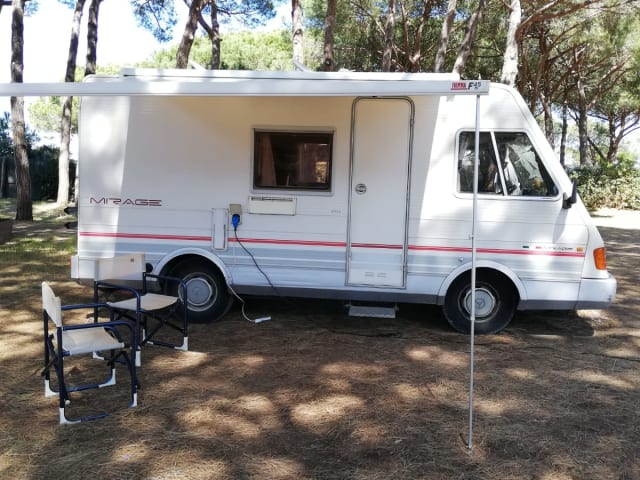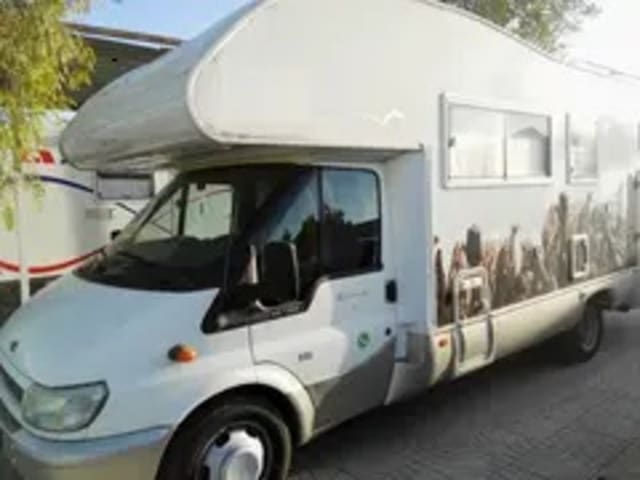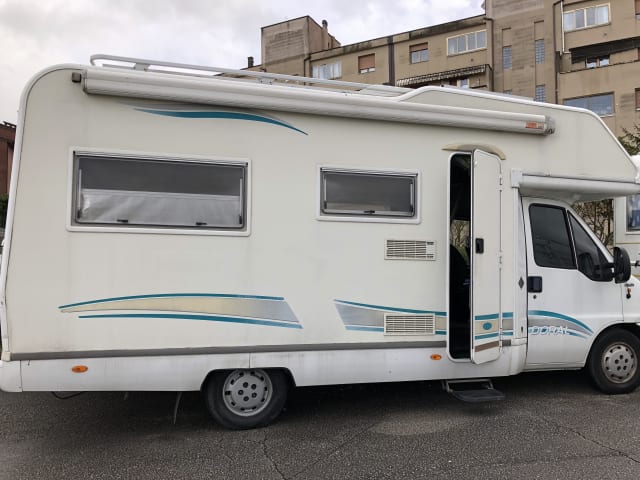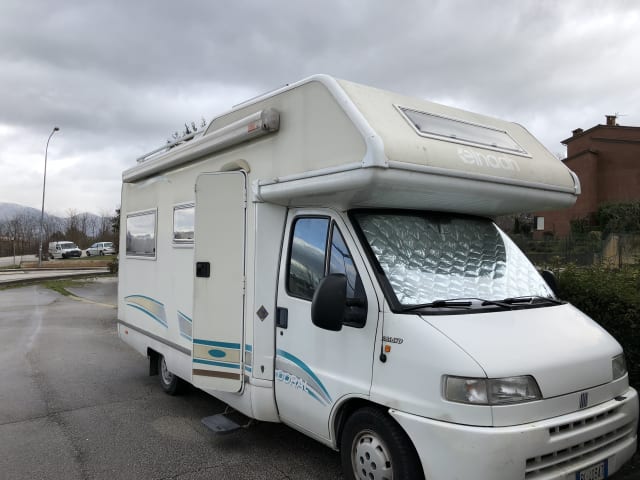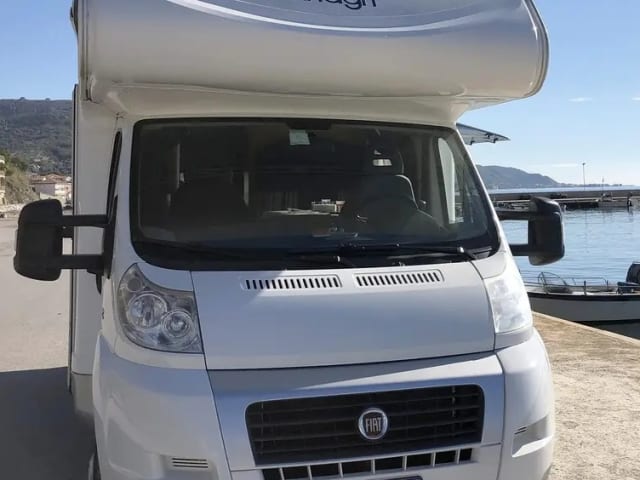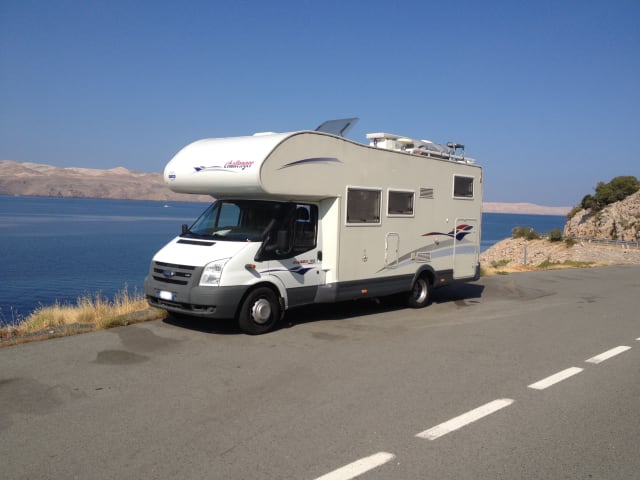Italy is home to some amazing road trips and truly iconic, once-in-a-lifetime destinations. The landscape and rich culture offer something for everyone, no matter your style of holidaying. The varied terrain is full of delights and new experiences, so it’s important to duck down unplanned detours and fully immerse yourself.
That being the case, in this blog, we haven’t planned out your itinerary for you. But we’ve explained the best routes for getting to Italy from the UK, France, and Germany. Then, starting in the north and heading south, we’ve highlighted our top destinations for a motorhome trip to Italy, and some of the best places to pitch up en route. There are a few details you need to know about driving your motorhome in Italy and current border policies, so read on to get completely set for an unforgettable Italian road trip!
Getting to Italy from the UK
For a scenic route, get the ferry to northern France (Calais, Dunkirk, Cherbourg or Caen). We recommend Calais. Head to Reims and on to Nancy in the east, then into Switzerland to get to Milan. This route will take you via Basel, Lucerne, and pass into northern Italy through the Gotthard Tunnel. Driving from France to Milan this way will take about 12 hours, and you’ll get to see some of Europe’s most spectacular mountain landscapes, all whilst following good-quality national roads.
Depending on where in the UK you’re entering France from, London’s Eurostar shuttle might prove a faster, more convenient route for the first leg of the trip.
For a more straightforward drive from France to Italy, simply use the French autoroute all the way. From Riems, go south to Troyes. Drive on to Dijon, Lyon, then into Switzerland. You’ll pass through Geneva and Turin and enter Italy in the dazzling seaside gem of Genoa; a city which is often missed but has a rich maritime history and boundless gastronomic delights. This is a more expensive option, as you’ll have to pay more for the French autoroute tolls.
You could also use the Mont Blanc tunnel in Chamonix, France, to get through the Alps if you’re aiming for the Italian Riviera, or Tuscany. However, there is a hefty cost for this tunnel.

Portofino, near Genoa
Best Motorhome Destinations in Italy
Of course, visiting Italy by motorhome means you’re completely free to drive wherever you want, getting off the beaten track and discovering this spectacular country’s true nature. Whilst we would usually highly recommend doing this, and avoiding busy cities and destinations, to miss out some of Italy’s key tourist sites would be to hugely lose out on experiencing Italian culture.

Lake Garda is not to be missed
-
Lake Garda
Lake Garda is Italy’s biggest lake, at 50km long. It’s an important tourist site under the shadow of the Dolomite Mountain range, and a spectacular place to cool down with a splash in clear, freshwater or take a ferry trip around the idyllic towns that perch above the waterline. With cypresses and cedars, olive trees, palm trees and flowers framing romantic villas and palazzos on the lakeside slopes, you really don’t want to miss out on this gorgeous part of Italy.
At the Verona end of Lake Garda, Camping Bergamini offers a well-shaded and spacious holiday campsite and a private, sandy lakeside beach for campers. Its 20 acres are covered by oaks (including one of the oldest in Italy), olive trees, mulberries, limes, maples, and acacias and caring for these natural assets is of great importance at this family-run site.
Price: Motorhome pitch prices vary extremely here, based on the servicing of the pitch and timing of your stay. Standard pitches range from €13.00 to €43.20, and adults pay from €6.90 to €17.50 each.
Location: Lazise - Location Bottona 37017, VR.
45.4660754212, 10.6653156244
-
Tuscany
Tuscany is a real treasure trove, where the rugged, hilly countryside brims with incredible wineries and Renaissance towns. It has some incredibly scenic roads which are ideal for road tripping along, such as the famous SR222 ‘Chiantigiana road’ which winds south from Florence to Siena.

Tuscany is famous for its hilltop towns
As with many other Italian cities, if you miss out on Florence when visiting Italy by motorhome, you might regret it. Florence is Tuscany’s city for lovers and artists. It’s dubbed ‘the cradle of the Renaissance’ and, according to UNESCO, it’s where the most universally recognised works of art in the world exist. The center boasts an incredible number of historic buildings and gardens, including the Medici Palace, the Uffizi paintings, and the Ponte Vecchio. Let yourself be enchanted by spending the day exploring the Boboli Gardens, and climbing the hill to the church of San Miniato al Monte to experience an enchanting view of the city!
If you’re looking for places to stay in Tuscany, it really doesn’t get better than a site with its own waterfall. Yep, at Camping le Sorgenti, a sulphur spring runs through the campsite, which is shaded by groves of chestnut trees and rings with birdsong. It’s idyllic but also well-facilitated; all pitches are serviced with electricity should you want it, there’s a bar, warm showers, mini market, table tennis and they organise hikes from the site, too.
Price: Campervan pitches are €10 in the low season and €11 in the high season. Adults pay €8 or €9 respectively, and the charge for electricity is €2.50 extra.
Location: Via della Faggiola, 19 50035 Palazzuolo sul Senio, FI.
44.117300025, 11.53607586
-
Rome
It’s a 273km drive from Florence to Rome, but it’s best to take this slow and soak up the sights like Siena and San Gimignano. The freedom to go at your own pace is what driving in a motorhome is all about, and definitely suits an immersive experience of Italy.
Of course, you could base your entire trip around discovering Rome, so spend a few days ticking off its bucket list attractions, like the Colosseum, the Pantheon, and eating very well!

Fori Imperiali, Campidoglio, Rome
We highly recommend staying at Roma Flash whilst you’re in this part of Italy. The site is a far cry from the bustling holiday resorts you’ll find nearer to Rome, but it’s only an hour away. The site is stunning, with views over Lake Bracciano and Castello Odesalchi. It’s peaceful, with flat, spacious and well-shaded pitches, some of which overlook the lake. You can enjoy watersports or take a boat trip on the lake, or swim in the onsite pool, and have dinner on their terrace with a spectacular sunset view. There are walking trails and cycling routes nearby, or you can get a shuttle to the city which operates from the site. Nearby, you can also explore the small towns of Lake Bracciano, the botanical gardens of S. Liberato, and the Farnese Palace of Caprarola.
Price: Motorhome pitches range from €21.00 to €39.00 depending on the season (including electric hook up).
Location: Via Settevene Palo, 19800 1 Tronco, Bracciano, 00062, RM.
42.1295, 12.1736
-
Abruzzo
For something a little different and off the beaten track, we recommend including Abruzzo in your motorhome trip to Italy. This region is technically southern though it lies just east of Rome, and has the fortune of combining both an Adriatic Coastline and the Apennine Mountains. Its rugged interior is covered mostly by national parks and nature reserves, but hilltop towns dotted around date to the Renaissance and medieval periods. The regional capital is a walled city, called L’Aquila, and we recommend visiting the Trabocchi coast, whose sandy coves are named after its traditional wooden fishing piers. Be sure to try the Abruzzo wine, too!
In Abruzzo, stay at Agricamping Garden Beach. This camper-friendly, beachfront site is a family-run, sustainable tourism enterprise which combines relaxing seaside camping with the appreciation of good, local food. Their ethos is centred around the well-being of campers and the surrounding landscape, and provides a unique experience within the sleepy hamlet of Cologna Spiaggia!
Price: Standard pitches are €28 in Spring and Autumn, and hike up to €40 in the summer. Electric hook up is an extra €2.50.
Location: Via degli Acquaviva angolo, Via Bozzino, 64026 Cologna Spiaggia, TE.
42.72651,13.98453
-
Amalfi
When visiting Italy by motorhome, you can’t miss driving down to the boot. The Amalfi coast on the east is undoubtedly one of Europe’s most beautiful coastlines. Towns that look like a box of wrapped chocolates from above, fragrant lemon groves and steep rock faces dripping in flowers, not to mention turquoise water and sweet fishing boats, the only downside to this area are the poorly constructed and busy roads but don’t worry - there are plenty bus and ferry options for getting up and down the Amalfi.
Read our blog about camping with a motorhome in this stunning area to find out more about the best place to pitch up and head along the coastline!
-
Puglia
On the heel of Italy’s boot, Puglia is a glittering part of Italy and not to be missed. It is dotted with towns of unique architecture, like Alberobello with its conical trulli, and Lecce with its extravagant baroque. You can wind through alleyways and explore churches and hidden piazzas, slow food trattorias and markets, then dip in the sea just a few steps away!

Puglia's iconic trulli houses
Whilst in Puglia, we recommend staying at Parco Camper La Torre, in Lecce. This is an intimate, woodland campsite that completely escapes any hustle and bustle of other tourist destinations. It’s spacious, shaded, and just a stone’s throw from a sandy beach. You are absolutely guaranteed quiet, freedom, and your own space to relax. If you need to contact the outside world, 80% of the campsite is reached by WiFi.
Price: Standard motorhome pitches range from €16.00 in the low season to €35.00 in the high season.
Location: Via Dubrovnik, 73026, Torre dell'Orso, LE.
40.27803,18.41447
During your campervan trip in Italy, you can of course use aires - called Sostas - to find free motorhome parking stopovers. Some may have a ticket machine for you to pay a small fee, but they still have the perk of not needing to be booked in advance. You can find these sites on Camper Contact, or Park4Night. It might be a good idea to get a physical guidebook to find these if your internet connection may be unreliable, but these go out of date quite quickly. As with many countries, the ones near cities are often crowded and may be targeted by thieves. So, for your own peace of mind, it is better to use a proper campsite.
If you’re big into wine or are visiting Italy for mainly to experience the food, check out the In Camper con Gusto or Agricamper Italia schemes, whereby a ‘free’ stopover is exchanged for you spending some money at local farms or vineyards, enjoying a meal at the restaurant, buying their products or taking a tour. The camping services may be basic, however, some may offer water points and electric hook up.

Italy is the ultimate road trip destination for foodies.
Driving your Motorhome to Italy
Driving in Italy has a slightly intimidating reputation, but it’s nothing to worry about. We have all the useful tips and advice you need for driving your campervan on this trip to Italy.
- Most motorhome sites require a tourist tax. This may just be a couple or euros, or up to €5 or €6 in peak months.
- To drive in Italy, you need at least three months remaining on your passport at your intended date of departure back home.
- You don’t need a green card to prove you have vehicle insurance, but we recommend at least having 3rd party insurance.
- Breakdown cover documentation isn’t compulsory, but we recommend it.
- You must have your vehicle V5 logbook with you, which shows the correct address, and a trailer certification if you’re towing.
- Vehicle safety equipment for driving in Italy includes a warning triangle, a reflective jacket (which is not compulsory to carry, but you can be find for not wearing one on the hard shoulder), spare wheel and tools for changing in or a tyre repair kit, and snow chains or winter tyres when conditions dictate (there will be road signs).
- If your motorhome has an overhanging load at the rear, like a bike rack, you have to display a reflectorised square panel measuring 50cm x 50cm with red and white diagonal stripes.
- If you’re coming from the UK, you also must display a UK sticker on the rear of your vehicle, instead of a GB sticker.
- Campervans, motorhomes and cars with caravans or trailers aren’t allowed to exceed 18.75m in total length, 4m in height, and 2.55m in width.
- Diesel in Italy costs about the same as in France and is slightly cheaper than in the UK. Many Italian garages have two fuel prices, because if you’re served by a forecourt attendant, you may pay more. Look for signs when you enter a garage in your motorhome; servizio for service and self for self-service.
- In many historical centres and major towns, there are areas called ‘Zone a Traffico Limitato’ or ZTL’s, which you cannot drive into. You’ll receive a fine by post if you do, as only residents are permitted to use these urban roads.
- In the cities of northern Italy, mid Italy, and Sicily, you’ll also find different low emission zones with differing standards, time periods and enforcement methods. In Milan and Palermo, these schemes combine LEZ and urban road tolling schemes.
- Be sure to observe the speed limits in Italy; you will be prosecuted for non-payment of fines, just as anywhere else in Europe and this hasn’t changed since Brexit, as the DVLA’s information-sharing agreement continues. Speed limits differ per weight of your vehicle. In urban areas, the limit for motorhomes both over and under 3,500kg is 50km/h. Outside of urban areas, it’s 90km/h for those under and 80km/h for those over. Main roads are 100km/h for those under (90km/h in poor weather), and 80km/h for those over. Motorways and autovias and 130km/h for those over (110km/h in poor weather) and 100km/h for those over.
- Pay attention to the rules of the road. Police can impose on-the-spot fines to drivers of foreign-registered vehicles and collect a quarter of the maximum fine there and then.
- In the unfortunate event that you get into an accident, you’ll need to complete the EU Accident Statement. Stop safely and use your hazard lights and warning triangle. A translation app might come in handy for exchanging details and be sure to take lots of photos to add to your insurance claim. If there’s an injury or the other party refuse to give you details, call 112.
- On the motorway, emergency telephones linked to an SOS telephone network are installed at 2km intervals. Two types of emergency telephone on Italian roads will either connect you to the emergency call centre, so you speak directly to an operator, or you may find one with a ‘spanner’ button to press for mechanical assistance or a ‘red cross’ button for medical help. A red light will show to let you know your request has been received.
Italian Toll Roads
Tolls in Italy are more expensive than Spain, but much cheaper than France. Not all the autovias have tolls, and those that do may only have them on some sections. It’s generally cheaper and quicker to take the toll roads because lesser roads sometimes are in worse condition. Motorhome drivers pay for a class B vehicle, regardless of the number of axles, so 100km of toll road driving will cost around €6. Tolls are pay as you go, so use your card or try to avoid using large notes. There are helpful route planning tools to help you calculate your toll road costs, such as Mappy and Via Michelin. If the machine has no change, it will give you a credit note which you can exchange for cash at an obscure highways’ office in an unknown town, so we don’t recommend this option!

When to go to Italy
To avoid the worst of the summer tourist crowds, particularly in the cities and regions of Tuscany and Umbria, plan your motorhome trip to Italy in the shoulder seasons of spring and autumn. During these months, you’ll still enjoy perfectly warm weather during the days unless you’re heading into the mountains, in which case bring a few layers just in case. For a more detailed insight into regional weather in Italy, visit this website.
If you don’t own a motorhome, the best way to experience this once-in-a-lifetime trip is to hire one directly from the owner!


